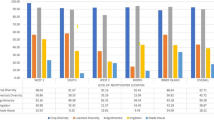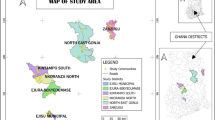Abstract
Sustainable intensification (SI) of farming systems aims to increase food production from existing farmland in ways that have a lower environmental impact and maintain the food production capacity over time. SI embraces a set of diverse agricultural technologies that share a common feature: their adoption is dependent on the interactions between farmers’ decision-making processes, locally specific agro-ecological conditions, and the traits of the technology itself. There are concerns about the sustainability of the maize mono-cropping systems that are in use in Laosc today. Therefore, we used discrete choice experiments (DCE) to explore the potential adoption or alternative agricultural systems. We analyse the heterogeneity of farmers’ preferences and willingness to pay for different cropping system attributes using a mixed logit model, and we discuss the possible drivers and barriers to the adoption of these more sustainable options. The results suggest the existence of four types of farmers: “fertility-minded”, “factor-constrained”, “maximisers”, and “risk-averse”. Each type of farmers was likely to react differently to the proposed sustainable intensification techniques. Overall, the DCE appeared to be an efficient tool to elicit the diversity of farmer preferences in an agricultural region and for fine-tuning strategies for successful research and development of sustainable intensification.

Similar content being viewed by others
Notes
The exact sentence used by the moderator was “I know a perfect upland crop, what question would you like to ask me, in order to know if you would decide to grow it or not?”
The full survey with farmers included a Best-Worst Scaling experiment to obtain the ranking of farm-level management priorities that we do not report in this paper, and the choice experiment for the choice of cropping systems analysed in this paper. It was felt that another set of experiments would have generated respondent fatigue, while not providing sufficient additional information at this stage of the research project.
As we were looking for homogenous groups of preferences, we could use an alternative method based on a latent class logit (LCM) model. However, as shown in Annex C, we did not find any compelling advantages in using the LCM. As the LCM does not take into account the additional variance potentially associated with the new alternatives (the EC), we opted for this two-step approach.
MRS calculations using the coefficients of the mixed logit model are also included in Table 1 of Annex D. Results showed that the MRS were of the same magnitude but higher when using the coefficients of the mixed logit model. For our discussion, we opted for the more conservative figures obtained with the CL model.
References
Adamowicz, W., Boxall, P., Williams, M., & Louviere, J. (1998). Stated preference approaches for measuring passive use values: choice experiments and contingent valuation. American Journal of Agricultural Economics, 80(1), 64–75.
Affholder, F., Jourdain, D., Quang, D. D., Tuong, T. P., Morize, M., & Ricome, A. (2010). Constraints to farmers’ adoption of direct-seeding mulch-based cropping systems: a farm scale modeling approach applied to the mountainous slopes of Vietnam. Agricultural Systems, 103(1), 51–62.
Alary, V., Nefzaoui, A., & Jemaa, M. B. (2007). Promoting the adoption of natural resource management technology in arid and semi-arid areas: modelling the impact of spineless cactus in alley cropping in Central Tunisia. Agricultural Systems, 94(2), 573–585.
Andersson, M., Engvall, A., & Kokko, A. (2007). Regional development in Lao PDR: growth patterns and market integration. Working Paper 234. Stockholm: Stockholm School of Economics.
Barham, B. L., Chavas, J.-P., Fitz, D., Ríos-Salas, V., & Schechter, L. (2015). Risk, learning, and technology adoption. Agricultural Economics, 46(1), 11–24.
Birol, E., Villalba, E. R., & Smale, M. (2009). Farmer preferences for milpa diversity and genetically modified maize in Mexico: a latent class approach. Environment and Development Economics, 14(4), 521–540.
Bocquého, G., Jacquet, F., & Reynaud, A. (2013). Expected utility or prospect theory maximisers? Assessing farmers’ risk behaviour from field-experiment data. European Review of Agricultural Economics, 41(1), 135–172.
Boussard, J.-M. (1969). The introduction of risk into a programming model: different criteria and the actual behavior of farmers. European Economic Review, 1(1), 92–121.
Campbell, B. M., Thornton, P., Zougmoré, R., van Asten, P., & Lipper, L. (2014). Sustainable intensification: what is its role in climate smart agriculture? Current Opinion in Environmental Sustainability, 8(Oct. 2014), 39–43.
Castella, J.-C., Jobard, E., Lestrelin, G., Nanthavong, K., & Lienhard, P. (2012). Maize expansion in Xieng Khouang province, Laos: what prospects for conservation agriculture? Paper presented at the The 3rd International Conference on Conservation Agriculture in Southeast Asia, Hanoi, 10-15/12/2012
Daniel, A. M., Persson, L., & Sandorf, E. D. (2018). Accounting for elimination-by-aspects strategies and demand management in electricity contract choice. Energy Economics, 73(2018), 80–90.
Duke, J. M., Borchers, A. M., Johnston, R. J., & Absetz, S. (2012). Sustainable agricultural management contracts: using choice experiments to estimate the benefits of land preservation and conservation practices. Ecological Economics, 74(Feb. 2012), 95–103.
EFICAS. (2017). Agrarian and land use transitions in maize production areas of Sayaboury and Xieng Khouang Provinces. EFICAS Annual Workshop. Luang Prabang: EFICAS Project.
Erdem, S., Campbell, D., & Thompson, C. (2014). Elimination and selection by aspects in health choice experiments: prioritising health service innovations. Journal of Health Economics, 38(Dec 2014), 10–22.
Fang, Y., & Wang, J. (2012). Selection of the number of clusters via the bootstrap method. Computational Statistics & Data Analysis, 56(3), 468–477.
Feder, G., Just, R. E., & Zilberman, D. (1985). Adoption of agricultural innovations in developing countries: a survey. Economic Development and Cultural Change, 33(25), 255–298.
Garnett, T., Appleby, M. C., Balmford, A., Bateman, I. J., Benton, T. G., Bloomer, P., Burlingame, B., Dawkins, M., Dolan, L., Fraser, D., Herrero, M., Hoffmann, I., Smith, P., Thornton, P. K., Toulmin, C., Vermeulen, S. J., & Godfray, H. C. J. (2013). Sustainable intensification in agriculture: premises and policies. Science, 341(6141), 33–34.
Greene, W. H. (2016). NLOGIT version 6: reference guide. New York: Econometric Software, Inc.
Greene, W. H., & Hensher, D. A. (2003). A latent class model for discrete choice analysis: contrasts with mixed logit. Transportation Research Part B: Methodological, 37(8), 681–698.
Hennig, C. (2010). FPC: Flexible Procedures for Clustering, available at https://cran.r-project.org/web/packages/fpc/fpc.pdf.
Hensher, D. (2014). Attribute processing as a behavioural strategy in choice making. In S. Hess & A. Daly (Eds.), Handbook of choice modelling (pp. 268–289). Cheltenham: Edward Elgar Publishing.
Hensher, D. A., Rose, J. M., & Greene, W. H. (2015). Applied choice analysis. Cambridge, U.K.: Cambridge University Press.
Hess, S., Stathopoulos, A., & Daly, A. (2012). Allowing for heterogeneous decision rules in discrete choice models: an approach and four case studies. Transportation, 39(3), 565–591.
Hijioka, Y., Lin, E., Pereira, J., Corlett, R., Cui, X., Insarov, G., Surjan, A., Field, C., Barros, V., & Mach, K. (2014). Asia climate change 2014: impacts, adaptation, and vulnerability, IPCC working group II contribution to AR5 (pp. 1327–1370). Cambridge UK and New York, USA: Cambridge: U. Press.
Jaeck, M., & Lifran, R. (2014). Farmers’ preferences for production practices: a choice experiment study in the Rhone River Delta. Journal of Agricultural Economics, 65(1), 112–130.
Johnston, R. J., Boyle, K. J., Adamowicz, W., Bennett, J., Brouwer, R., Cameron, T. A., Hanemann, W. M., Hanley, N., Ryan, M., & Scarpa, R. (2017). Contemporary guidance for stated preference studies. Journal of the Association of Environmental and Resource Economists, 4(2), 319–405.
Jourdain, D., Boere, E., van den Berg, M., Dang, Q. D., Cu, T. P., Affholder, F., & Pandey, S. (2014). Water for forests to restore environmental services and alleviate poverty in Vietnam: a farm modeling approach to analyze alternative PES programs. Land Use Policy, 41(2014), 423–437.
Kahneman, D., & Tversky, A. (1979). Prospect theory: an analysis of decision making under risk. Econometrica, 47(2), 263–291.
Kahneman, D., & Tversky, A. (2013). Prospect theory: an analysis of decision under risk. In L. C. MacLean & W. T. Ziemba (Eds.), Handbook of the fundamentals of financial decision making: Part II (pp. 99–127). Singapore: World Scientific.
Knight, F. H. (1921). Risk, uncertainty and profit. Boston: Houghton Mifflin Co..
Knowler, D. (2015). Farmer adoption of conservation agriculture: a review and update. In M. Farooq & K. H. M. Siddique (Eds.), Conservation agriculture (pp. 621–642). Cham: Springer International Publishing.
Knowler, D., & Bradshaw, B. (2007). Farmers’ adoption of conservation agriculture: a review and synthesis of recent research. Food Policy, 32(1), 25–48.
Lairez, J. (2018). Integrated assessment of cropping systems sustainability considering the rapid dynamics of farms. Hard data cited in a PhD Manuscript in preparation.
Läpple, D., Holloway, G., Lacombe, D. J., & O’Donoghue, C. (2017). Sustainable technology adoption: a spatial analysis of the Irish Dairy Sector. European Review of Agricultural Economics, 44(5), 810–835.
Leong, W., & Hensher, D. A. (2012). Embedding decision heuristics in discrete choice models: a review. Transport Reviews, 32(3), 313–331.
McFadden, D. (1974). The measurement of urban travel demand. Journal of Public Economics, 3(4), 303–328.
von Neumann, J., & Morgenstern, O. (1944). Theory of games and economic behavior. Princeton (USA): Princeton University Press.
Ortega, D. L., Waldman, K. B., Richardson, R. B., Clay, D. C., & Snapp, S. (2016). Sustainable intensification and farmer preferences for crop system attributes: evidence from Malawi’s central and southern regions. World Development, 87(2016), 139–151.
Pagiola, S. (1993). Soil conservation and the sustainability of agricultural production (p. 199). Stanford: Stanford University, Food Research Institute, Ph.D..
Roumasset, J. A., Boussard, J.-M., & Singh, I. (Eds.). (1979). Risk, uncertainty and agricultural development. Laguna: Southeast Asian Regional Center for Graduate Study and Research in Agriculture and Agricultural Development Council.
Roy, A. D. (1952). Safety first and the holding of assets. Econometrica, 20(3), 431–449.
Scarpa, R., Ferrini, S., & Willis, K. (2005). Performance of error component models for status-quo effects in choice experiments. In R. Scarpa & A. Alberini (Eds.), Applications of simulation methods in environmental and resource economics (pp. 247–273). Dordrecht: Springer.
Shackle, G. L. S. (1961). Decision, order, and time in human affairs. Cambridge: Cambridge University Press.
Tversky, A. (1972). Elimination by aspects: a theory of choice. Psychological Review, 79(4), 281–299.
Useche, P., Barham, B. L., & Foltz, J. D. (2013). Trait-based adoption models using ex-ante and ex-post approaches. American Journal of Agricultural Economics, 95(2), 332–338.
Valentin, C., Agus, F., Alamban, R., Boosaner, A., Bricquet, J. P., Chaplot, V., de Guzman, T., de Rouw, A., Janeau, J. L., Orange, D., Phachomphonh, K., Do Duy, P., Podwojewski, P., Ribolzi, O., Silvera, N., Subagyono, K., Thiébaux, J. P., Tran Duc, T., & Vadari, T. (2008). Runoff and sediment losses from 27 upland catchments in Southeast Asia: Impact of rapid land use changes and conservation practices. Agriculture, Ecosystems & Environment, 128 (4).225-238.
Van Loo, E. J., Caputo, V., Nayga, R. M., & Verbeke, W. (2014). Consumers’ valuation of sustainability labels on meat. Food Policy, 49(2014), 137–150.
Vongvisouk, T., Broegaard, R. B., Mertz, O., & Thongmanivong, S. (2016). Rush for cash crops and forest protection: neither land sparing nor land sharing. Land Use Policy, 55(2016), 182–192.
Ward, P. S., Ortega, D. L., Spielman, D. J., & Singh, V. (2014). Heterogeneous demand for drought-tolerant rice: evidence from Bihar, India. World Development, 64(2014), 125–139.
Yiridoe, E. K., Langyintuo, A. S., & Dogbe, W. (2006). Economics of the impact of alternative rice cropping systems on subsistence farming: whole-farm analysis in northern Ghana. Agricultural Systems, 91(1–2), 102–121.
Funding
This work was supported by the Directorate-General for Development and Cooperation—EuropeAid (EuropeAid/132-657/L/ACT/LA) and the Agence Française de Développement (Conservation Agriculture within the Northern Upland Development Program, NUDP).
Author information
Authors and Affiliations
Corresponding author
Ethics declarations
Conflict of interest
The authors declare that they have no conflict of interest.
Additional information
Publisher’s note
Springer Nature remains neutral with regard to jurisdictional claims in published maps and institutional affiliations.
Rights and permissions
About this article
Cite this article
Jourdain, D., Lairez, J., Striffler, B. et al. Farmers’ preference for cropping systems and the development of sustainable intensification: a choice experiment approach. Rev Agric Food Environ Stud 101, 417–437 (2020). https://doi.org/10.1007/s41130-020-00100-4
Received:
Accepted:
Published:
Issue Date:
DOI: https://doi.org/10.1007/s41130-020-00100-4




